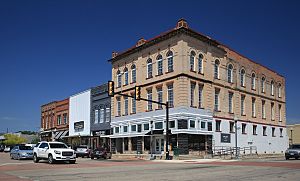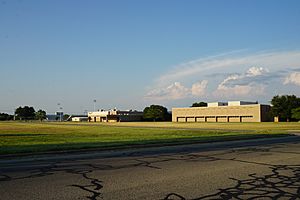Bonham, Texas facts for kids
Quick facts for kids
Bonham, Texas
|
|
|---|---|

Downtown Bonham, Texas (2020)
|
|
| Motto(s):
"The Star of North Texas"
|
|
| Country | United States |
| State | Texas |
| County | Fannin |
| Named for | James Bonham |
| Area | |
| • Total | 9.83 sq mi (25.47 km2) |
| • Land | 9.83 sq mi (25.47 km2) |
| • Water | 0.00 sq mi (0.00 km2) |
| Elevation | 614 ft (187 m) |
| Population
(2020)
|
|
| • Total | 10,408 |
| • Density | 1,058.8/sq mi (408.64/km2) |
| Time zone | UTC-6 (Central (CST)) |
| • Summer (DST) | UTC-5 (CDT) |
| ZIP code |
75418
|
| Area codes | 430, 903 |
| FIPS code | 48-09328 |
| GNIS feature ID | 2409878 |
Bonham is a city in Texas, United States. It is the main city and county seat of Fannin County, Texas. In 2020, about 10,408 people lived there. The city is named after James Bonham, who was a hero at the Battle of the Alamo. Bonham is part of the Texoma region, which is in northern Texas and southern Oklahoma.
Contents
History of Bonham, Texas
Bonham is one of the oldest cities in Texas. It began in 1837 when Bailey Inglish built a two-story fort called Fort Inglish. This fort was about two miles from where downtown Bonham is now. Inglish and his friends settled there in the summer of 1837. They first called the settlement "Bois D'Arc."
In 1843, the Congress of the Republic of Texas named the city Bloomington. But soon after, they changed the name to Bonham. This was to honor James Butler Bonham, who bravely defended the Alamo. On February 2, 1848, Bonham officially became a city. There is a statue of James Bonham on the courthouse grounds. It was made in 1936 by Texas sculptor Allie Tennant.
Growth and Development in Bonham
Bonham started to grow a lot after the Texas and Pacific Railway came to the city. By 1885, Bonham had many important things. These included six churches, three colleges, and two public schools. There were also three weekly newspapers, a sawmill, and two grain mills. The city had a power plant and about 2,300 people living there.
In 1890, streetcars were added, making it easier to get around. An ice plant also opened, and the Texas Power and Light Company started providing electricity. By 1925, natural gas lines were connected to the city.
Bonham and Baseball History
Bonham has a history with minor league baseball. Teams from Bonham played in 1898, and from 1911 to 1914, and again from 1921 to 1922. The teams were part of the Class D Texas-Oklahoma League and the Independent Southwestern League. Each season, the Bonham teams had a different name. For example, the 1914 team was called the Bonham Sliders. A famous player, Baseball Hall of Fame member Kid Nichols, was their manager that year.
Bonham During World War II
During World War II, Bonham played a role in the war effort. A training camp and an aviation school for the United States Army Air Forces were built nearby. There was also a camp for German prisoners of war. You can still visit parts of this camp today. It is located about half a mile north of US 82.
Geography and Climate
Bonham is located in Texas. The U.S. Census Bureau says the city covers about 25.3 square kilometers (9.8 square miles). All of this area is land.
Bonham's Climate
Bonham has a climate with hot, humid summers. The winters are usually mild to cool. This type of weather is called a humid subtropical climate. On climate maps, it is shown as "Cfa."
| Climate data for Bonham, Texas (1991–2020 normals, extremes 1903–present) | |||||||||||||
|---|---|---|---|---|---|---|---|---|---|---|---|---|---|
| Month | Jan | Feb | Mar | Apr | May | Jun | Jul | Aug | Sep | Oct | Nov | Dec | Year |
| Record high °F (°C) | 82 (28) |
92 (33) |
96 (36) |
98 (37) |
104 (40) |
108 (42) |
112 (44) |
115 (46) |
109 (43) |
103 (39) |
89 (32) |
86 (30) |
115 (46) |
| Mean daily maximum °F (°C) | 52.9 (11.6) |
57.3 (14.1) |
65.2 (18.4) |
73.4 (23.0) |
80.6 (27.0) |
88.9 (31.6) |
93.6 (34.2) |
93.8 (34.3) |
86.9 (30.5) |
76.5 (24.7) |
64.5 (18.1) |
54.9 (12.7) |
74.0 (23.3) |
| Daily mean °F (°C) | 42.8 (6.0) |
46.7 (8.2) |
54.4 (12.4) |
62.4 (16.9) |
71.0 (21.7) |
79.3 (26.3) |
83.5 (28.6) |
83.1 (28.4) |
75.8 (24.3) |
64.8 (18.2) |
53.4 (11.9) |
44.8 (7.1) |
63.5 (17.5) |
| Mean daily minimum °F (°C) | 32.7 (0.4) |
36.0 (2.2) |
43.6 (6.4) |
51.4 (10.8) |
61.4 (16.3) |
69.6 (20.9) |
73.4 (23.0) |
72.4 (22.4) |
64.8 (18.2) |
53.2 (11.8) |
42.3 (5.7) |
34.8 (1.6) |
53.0 (11.7) |
| Record low °F (°C) | −5 (−21) |
−5 (−21) |
9 (−13) |
22 (−6) |
32 (0) |
48 (9) |
52 (11) |
52 (11) |
34 (1) |
19 (−7) |
8 (−13) |
−4 (−20) |
−5 (−21) |
| Average precipitation inches (mm) | 2.81 (71) |
3.10 (79) |
4.30 (109) |
4.01 (102) |
4.94 (125) |
4.46 (113) |
3.21 (82) |
2.89 (73) |
4.07 (103) |
4.58 (116) |
3.48 (88) |
3.66 (93) |
45.51 (1,156) |
| Average snowfall inches (cm) | 0.3 (0.76) |
0.5 (1.3) |
0.0 (0.0) |
0.0 (0.0) |
0.0 (0.0) |
0.0 (0.0) |
0.0 (0.0) |
0.0 (0.0) |
0.0 (0.0) |
0.0 (0.0) |
0.0 (0.0) |
0.3 (0.76) |
1.1 (2.8) |
| Average precipitation days (≥ 0.01 in) | 6.1 | 6.9 | 7.9 | 6.8 | 8.4 | 6.8 | 4.9 | 4.7 | 5.5 | 6.1 | 5.5 | 6.0 | 75.6 |
| Average snowy days (≥ 0.1 in) | 0.1 | 0.2 | 0.0 | 0.0 | 0.0 | 0.0 | 0.0 | 0.0 | 0.0 | 0.0 | 0.0 | 0.1 | 0.4 |
| Source: NOAA | |||||||||||||
People of Bonham
| Historical population | |||
|---|---|---|---|
| Census | Pop. | %± | |
| 1850 | 211 | — | |
| 1860 | 477 | 126.1% | |
| 1870 | 928 | 94.5% | |
| 1880 | 1,889 | 103.6% | |
| 1890 | 3,361 | 77.9% | |
| 1900 | 5,042 | 50.0% | |
| 1910 | 4,844 | −3.9% | |
| 1920 | 6,008 | 24.0% | |
| 1930 | 5,655 | −5.9% | |
| 1940 | 6,349 | 12.3% | |
| 1950 | 7,049 | 11.0% | |
| 1960 | 7,357 | 4.4% | |
| 1970 | 7,698 | 4.6% | |
| 1980 | 7,338 | −4.7% | |
| 1990 | 6,686 | −8.9% | |
| 2000 | 9,990 | 49.4% | |
| 2010 | 10,127 | 1.4% | |
| 2020 | 10,408 | 2.8% | |
| U.S. Decennial Census | |||
Bonham's Population in 2020
| Race | Number | Percentage |
|---|---|---|
| White (NH) | 6,537 | 62.81% |
| Black or African American (NH) | 1,506 | 14.47% |
| Native American or Alaska Native (NH) | 78 | 0.75% |
| Asian (NH) | 80 | 0.77% |
| Pacific Islander (NH) | 6 | 0.06% |
| Some Other Race (NH) | 20 | 0.19% |
| Mixed/Multi-Racial (NH) | 348 | 3.34% |
| Hispanic or Latino | 1,833 | 17.61% |
| Total | 10,408 |
In 2020, the city of Bonham had 10,408 people. There were 2,963 households, which are groups of people living together. About 28.8% of these households had children under 18. Many households (41.3%) were married couples living together.
The population was spread out by age. About 21% of the people were under 19 years old. Around 15.2% of the people were 65 years or older. The average age in Bonham was 36 years.
Education in Bonham
The Bonham Independent School District serves the city. The main high school for students in Bonham is Bonham High School.
For a while, Grayson County College had a campus in Bonham. However, it closed in 2012.
Transportation in Bonham
Several important roads pass through or near Bonham. These include U.S. Route 82, Texas State Highway 78, Texas State Highway 56, and Texas State Highway 121. These highways help people travel to and from Bonham.
Notable People from Bonham
Many interesting people have come from Bonham, Texas. Here are a few:
- Homer Blankenship and Ted Blankenship: Both were Major League Baseball pitchers in the 1920s.
- Charlie Christian: A very important jazz guitarist.
- Charlie Cole: A photojournalist famous for his picture of the "Tank Man" during the Tiananmen Square protests of 1989.
- Danny Darwin: Another Major League Baseball pitcher.
- Karen Dalton: A folk blues singer.
- John Wesley Hardin: A well-known figure from the late 1800s in Texas.
- Joe Morgan: A Baseball Hall of Fame second baseman.
- Sam Rayburn: A famous politician who was once the Speaker of the U.S. House of Representatives.
See also
 In Spanish: Bonham (Texas) para niños
In Spanish: Bonham (Texas) para niños


